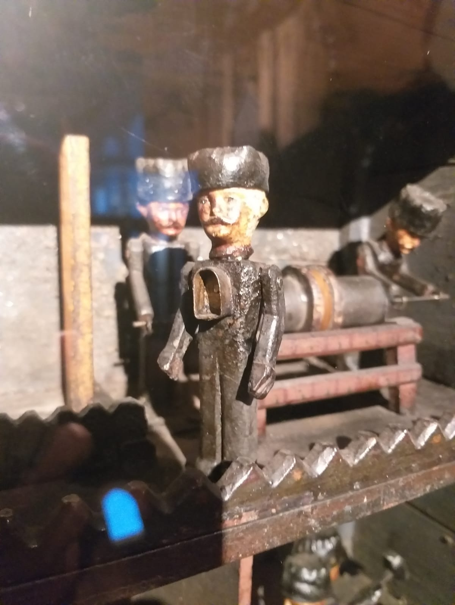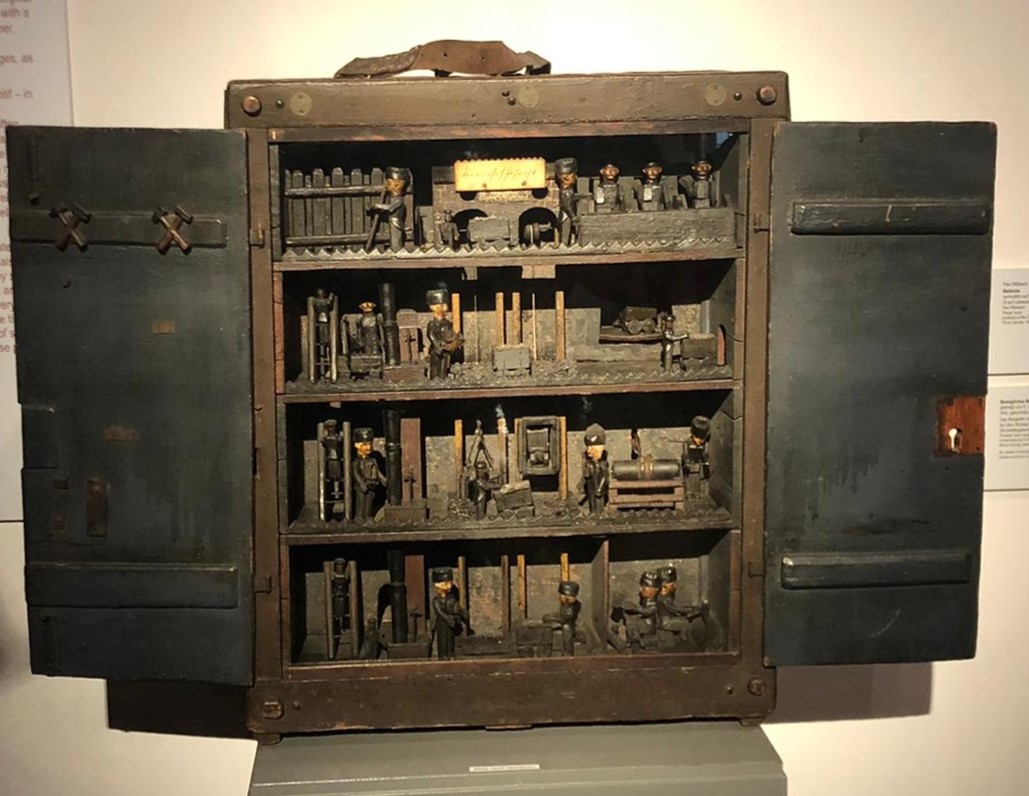Burcu Buber,
an architect from Turkey
Katerina Resek,
a student from USA/Brasil, studying in Germany
Freiberg’s dark underground caves made the city prosper and fueled the beginning of the city’s story. After the discovery of silver in the middle of the 12th century, settlers arrived in Freiberg. The city started its story as a small village but as they dug more and added new layers, the city grew and spread. Around the 16th century, it reached its heyday and became known for people who can mine. In these times, the underground tunnels of the city was was as active as the life being lived above it. The city was fully operating and prospering from the silver.
A CITY THAT FUNCTIONS IN ALL LAYERS
If you are curious about how mining looked like, this wooden box can give you a rough idea. There are four levels and in each level, a different phase of mining is shown . The display looks complex but functions through a shockingly simple mechanism. Every action connects through one cotton thread which is renewed frequently and stands as the only part that is not original today. Also, the glass was added later in the museum to protect the wooden elements. The mechanism is activated by the lever on the right side, and miners start working just like they would in old Freiberg. In this sense, it resembles a music box. There are relatively small human figures that shows the child-labour reality. In these times young boys were chosen as miners and placed in the cold, hard conditions of the mines depending on their strength. According to the guide at the museum, the dirt on the miners’ faces may depict the dirt from the mine or a colour change caused by the years passing. The wooden box has two shoulder straps, so it is portable and therefore called “Buckelbergwerk” in German. That can be translated in English “backmountainwork”. But, who was carrying that?

FROM CARVING THE GROUND TO WOOD
One day, a miner named Gerlach went to his shift as he did every day. But that day, an unfortunate detonation occurred and he became injured. He was a miner from the beginning, it was his sole identity. The denotation not only damaged his arm, but his identity as well. In order to still make a living, he decided to construct a wooden box demonstrating his previous life. He carried his wooden box to different places and that became profitable and turned into this new job. He would show it to the public and satisfy their curiosity about life below the ground. Since it is close to Freiberg, he generally travelled to the Christmas Market in Dresden during Christmas time and earned money from the donations. While this took place in 1910, a similar situation happened to the mining industry in Freiberg. Around 1913, the industry died out. Just like Gerlach and his past that only was based on mining, Freiberg as a city share the same destiny and looked for a way to survive. The “Silberstadt” or Silver City lost its main characteristic. What would happen now in the city where the underground once shaped life above?
THE END OF THE STORY and A NEW BEGINNING
The wooden box was active once just like the mining industry. Now, it has stopped and has become a part of the exhibition in the Municipal and Mining Museum. The same story happened to the miners in Freiberg. This box represents more than what happens below the ground, it serves as a metaphor for what happened to the mines and the identity of the city.
Freiberg with its unique story and its current situation proves to be a good example of how an industrial area can be turned into a display area in the case of loss of function. Just like the wooden box opened its doors to the viewers, the mines opened theirs to the visitors. Both are away from their original users, their functions were transformed and adapted to the new Freiberg. They feel a bit otiose when we compare them with the city’s past but they still draw interest. Mining defined Gerlach and the city and they both continued their life based on the traces of what they know the best. Mines in Freiberg reached the stage of a wise old man who cannot work anymore but could share his fine experiences.
Founded in 1765, the Technical University of Freiberg continue their studies on mining in its very original place; in the miners. Alongside hosting visitors, miners host some educational areas that are fully equipped to conduct complete research. They offer a tremendous opportunity to study mining where the past methods connect with present technology. Therefore, Freiberg teaches us identity can be as fragile as Gerlauch’s wooden box, yet it can also be adapted and developed as time goes on while still paying tribute to the past.
XXXXXXXXXXXXXXXXX